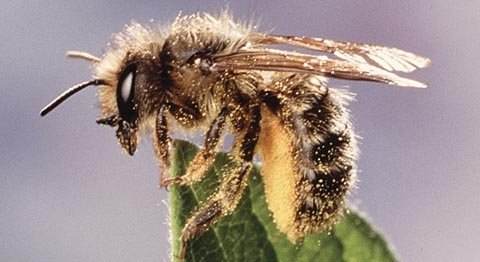
Hornfaced bee (Osmia cornifrons). (Photo by Dr. Suzanne Batra)
Hornfaced bees are solitary, which means that instead of having queens and workers, each female mates, makes her own nest cells of mud, collects food (nectar and pollen), and lays eggs. Male hornfaced bees, unlike honeybee drones, visit and pollinate flowers.
Adult bees are active for four to six weeks each spring before they die. The nests of hornfaced bees can be removed from the orchard after pollination and stored in a shed for the ten months when they aren’t needed. Inside the nests, the dormant brood and young bees will spend much of the year developing into adults, and be dormant until taken out from storage the following spring. If spring temperatures warm up to about 40° F before bloom begins, the hives will need to be kept in cold storage until pollination to delay the bees’ life cycle and coincide it with bloom.
In the wild, they make their nests in hollow reeds, bamboo sections, and beetle holes in wood.
For more information about management of hornfaced bees for orchard pollination, visit: www.pollinatorparadise.com/Solitary_Bees/Hornface.htm.

Leave A Comment